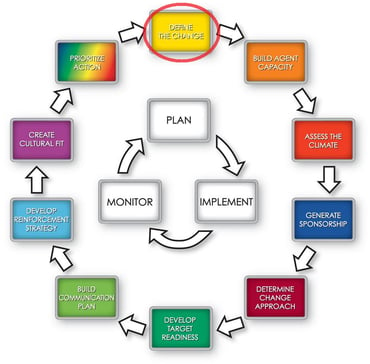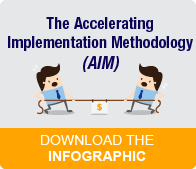The starting point for every change management project should be a clear, compelling definition of the change. This is true whether the business change is a minor procedural change, or a transformational change affecting the entire organization. It sounds so basic... but this essential, first step is all too often forgotten in the hustle and bustle of a real world organizational change. 
Imagine for a moment you are going to build your dream home from the ground up. Would the construction crew break ground without a comprehensive plan for what the house will look like upon completion? Never in a million years, right? Now, think about one of your organization’s past change initiatives. Was there a commonly understood definition of what was changing? In other words, did each individual affected by the change have a clear understanding of what behaviors were expected of them once the change was in place? Our guess is... probably not.
Risks
One of the most common barriers to accelerating a change is the lack of a common understanding of what the change actually is. Too often we are called into client projects where there is no clear, concise picture of what the future looks like, causing the entire project to be at risk from the very beginning. It's a distinct case of "if you don't know where you are going, how will you know when you get there?"
Most times, we see a project team that has set clear objectives for a timeline, a budget, and even perhaps... the technical objectives. The sub-optimization culprits are typically the lack of a commonly-held definition of the business objectives and the human objectives. These human objectives are the behaviors you need to see in the future if the change is implemented successfully.
Herein lies the problem. The fact is... there is no change unless people change their behavior. If you don’t get to behavior change, you are just installing the change, not implementing it. In order to have a successful implementation, there are 5 metrics that must be met:
- On Time
- On Budget
- Technical Objectives Met
- Business Objectives Met
- Human Objectives Met

IMA’s proprietary Change Management Methodology, the Accelerating Implementation Management (AIM) provides a repeatable process and deliverables to ensure every initiative meets all 5 of these objectives. Each element of AIM identifies a core set of actions that drive implementation and Return on Investment. While the elements don’t occur in a chronological fashion, you can’t begin without a clear change definition. So the first “to do” is always to ensure you have thoroughly defined change.
How to Define the Change
In order to properly define the change, you need to identify the behavior gap between the current state and the future state. In order to do so, there are four questions that need to be asked:
What is changing?
The answer to this question defines where you are moving from (the current state) and what you are moving to (the future state). Most importantly, it answers what success will look like when you get there.
Why you are changing?
Answering this question defines the business reason for the change. The first questions people usually ask when hearing about a change is, “What’s in it for me?” (the WIIFM) and “What does this change mean to me in my job?” These questions are not just for the “front line.” In fact, until your Sponsors have answers to these questions for their own personal situation they can’t effectively act as Sponsors!
What are the consequences for not changing?
The answer to this question defines in business AND human terms the downsides or risks of not changing.
How will success be measured?
How will progress be monitored and measured? What time frames will be attached to these measures?
Prescription for Success
How do you know when you’ve properly defined the change? Here’s a checklist you can use to ensure your definition of the change will be effective.
- A clear and compelling business case for change exists, addressing what, why, consequences of not changing, the WIIFM, and how success will be measured.
- The business case has been clearly communicated to all impacted by the change.
- All Targets of the change know how to get additional concerns/questions answered.
- Behavioral objectives are established and commonly understood.
- Success measures are spelled out.
- Leadership agrees with all of the above.
A compelling definition that addresses all 5 metrics for implementation success-- on time, on budget, all business, technical, and human objectives met, is an essential component of any change initiative. Do you have a repeatable change process like AIM that ensures that your projects are thoroughly defined on the human side each and every time?


